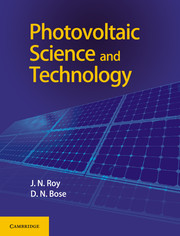Book contents
- Frontmatter
- Dedcation
- Contents
- Figures
- Tables
- Preface
- Acknowledgments
- 1 Introduction to Solar Energy and Solar Photovoltaics
- 2 Crystalline Silicon Cells
- 3 Thin Film Solar Cells
- 4 III-V Compound, Concentrator and Photoelectrochemical Cells
- 5 Organic and Polymer Solar Cells
- 6 Manufacture of c-Si and III-V-based High Efficiency Solar PV Cells
- 7 Manufacture of Solar PV Modules
- 8 Characterization, Testing and Reliability of Solar PV Module
- 9 Overview of Solar PV System Technology and Design
- 10 Design and Implementation of Off-Grid and On-Grid SPV Systems
- Index
- References
7 - Manufacture of Solar PV Modules
Published online by Cambridge University Press: 05 July 2018
- Frontmatter
- Dedcation
- Contents
- Figures
- Tables
- Preface
- Acknowledgments
- 1 Introduction to Solar Energy and Solar Photovoltaics
- 2 Crystalline Silicon Cells
- 3 Thin Film Solar Cells
- 4 III-V Compound, Concentrator and Photoelectrochemical Cells
- 5 Organic and Polymer Solar Cells
- 6 Manufacture of c-Si and III-V-based High Efficiency Solar PV Cells
- 7 Manufacture of Solar PV Modules
- 8 Characterization, Testing and Reliability of Solar PV Module
- 9 Overview of Solar PV System Technology and Design
- 10 Design and Implementation of Off-Grid and On-Grid SPV Systems
- Index
- References
Summary
INTRODUCTION
Solar Photovoltaic (SPV) modules occupy an important position in the value chain [1–5] (see Figure 9.1). Crystalline silicon (c-Si) is currently the preferred technology with a market share of about 85%. c-Si modules are made using crystalline silicon (Si) solar cells as the starting material. Several such cells are connected to make modules. The manufacturing process for c-Si modules is less complex than that for thin film modules. However, the value chain is quite long (see Figure 9.1) and more process steps in cell manufacture are required prior to module manufacturing. There are also processes, such as single crystal growth in the value chain, which require a substantial amount of electrical energy.
Thin film modules are made with an entirely different approach. These modules are made using a full size substrate (actually superstrate), typically glass with transparent conductive coating and use deposition techniques such as Plasma Enhanced Chemical Vapour Deposition (PECVD). For a-Si cells, layers of p, i and n are deposited sequentially to form the junction for PV conversion. Expensive and energy-intensive crystal growth required in c-Si technology is thus avoided. Historically, CdS/Cu2S were the first thin film cells invented in 1954. But, these were not commercially successful due to low efficiencies and degradation with time. Nowadays semiconductors such as amorphous Si (a-Si), CdTe or CIGS are used in thin film cells. Amorphous-silicon uses PECVD deposited a-Si as the active material. Single, as well as tandem junction a-Si films can be used to form a SPV module. A composite technology using a combination of a-Si and c-Si, called Heterojunction with Intrinsic Thin Layer (HIT) has also been developed. Cadmium Telluride (CdTe) and Copper Indium Gallium Selenide (CIGS) are the other two thin film materials that are being used for commercial SPV technology. Thin film technology has a much shorter value chain with lower electricity consumption than c-Si technology, PECVD being the only complex process. The cost per WP and payback period of thin film technologies is therefore lower than for c-Si technology. Another difference is that the temperature co-efficient of power output is less for thin film cells. This is an advantage in a tropical country such as India. Nevertheless, c-Si is still preferred due to higher efficiency and reliability.
- Type
- Chapter
- Information
- Photovoltaic Science and Technology , pp. 203 - 258Publisher: Cambridge University PressPrint publication year: 2017



